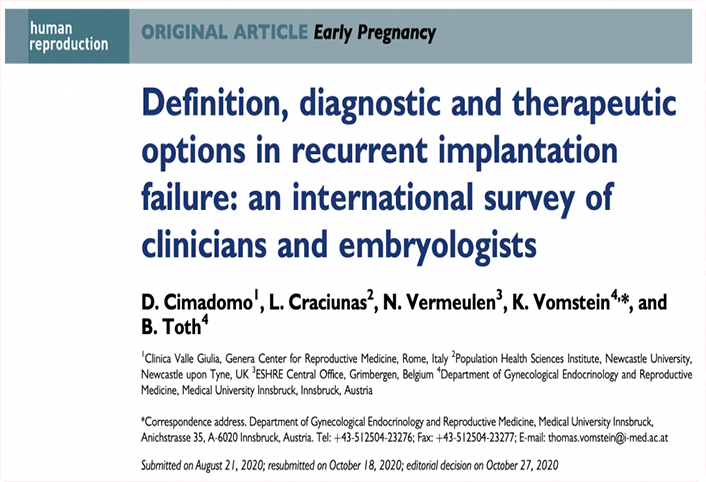
Definition, diagnostic and therapeutic options in recurrent implantation failure: an international survey of clinicians and embryologists
D. Cimadomo, L. Craciunas, N. Vermeulen, K. Vomstein, B. Toth
Human Reproduction, deaa317, https://doi.org/10.1093/humrep/deaa317 Published: 12 December 2020
Abstract
STUDY QUESTION: What is the global variability in recurrent implantation failure (RIF) definition, investigation and therapy, currently offered to patients undergoing IVF?
SUMAMRY ANSWER: Definitions, diagnostic investigations and treatments offered to RIF patients differ widely amongst assisted repro- duction healthcare professionals and clinical guidelines on RIF are urgently needed.
WHAT IS KNOWN ALREADY: RIF affects around 10% of patients undergoing IVF worldwide. There is no consensus on the definition of RIF, its diagnostic investigations or the therapeutic options, which leads to inconsistencies in clinical practice.
STUDY DESIGN, SIZE, DURATION: A cross-sectional study of clinicians and embryologists was conducted between May and June 2020. The survey included 43 questions aimed at understanding participants’ background and their current practice with regards to defin- ing, investigating and managing RIF. The questions were designed by the European Society of Human Reproduction and Embryology (ESHRE) Special Interest Group (SIG) on implantation and early pregnancy following three consensus meetings.
PARTICIPANTS/MATERIALS, SETTING, METHODS: A total of 8579 ESHRE members from 6916 IVF centers were invited to par- ticipate using two global email calls based on their pre-specified interest in implantation and early pregnancy. SurveyMonkey and SPSS were used for data collection and analysis, respectively. Furthermore, differences were reported in the answers of European and non-European professionals, as well as between public and private settings and among clinicians clustered according to the average number of RIF patients treated per year.
MAIN RESULTS AND THE ROLE OF CHANCE: The final data set included 735 clinicians and 300 embryologist or IVF-biologists. The majority defines RIF based on the number of failed embryo transfers (ETs) with the most common threshold adopted being three ETs both fresh and frozen. More than two-thirds take lifestyle factors into account, mainly drugs, smoking and BMI. The highest consensus on which diagnostic investigations should be performed was reached for anatomical malformations and gynecological aspects focusing on hydrosalpinx, Asherman’s syndrome, endometrial thickness and endometriosis. Concerning treatment of RIF patients, the highest consen- sus was reached for preconceptional therapies, including BMI adjustment, smoking and endometritis followed by therapies during IVF procedures.
LIMITATIONS, REASONS FOR CAUTION: The response rate was relatively low, but comparable to other surveys.
WIDER IMPLICATIONS OF THE FINDINGS: A consensus on definition, diagnosis and treatment of RIF would help to reduce costly, time-consuming and poorly validated approaches.
STUDY FUNDING/COMPETING INTEREST(S): No external funding was used. B.T. received support from Bayer for Clinical trials concerning endometriosis and Ferring for clinical trials concerning ovarian stimulation. She received reimbursement for travel expenses from Astropharm, Ferring. Dr Kade and is a shareholder of Reprognostics. She is a board member of the Austrian Society for Obstetrics

